Where do you look for a lost city?
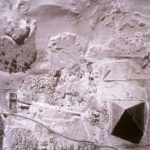
The Giza Plateau, Egypt
AERA’s search was helped by eliminating any areas where the ancient Egyptians would NOT have built their pyramid settlement.
The Pyramids are surrounded by other monuments of the Old Kingdom (2575-2465 BC) that restrict the available space on the Giza Plateau:
- Pyramid temples, causeways, and valley temples once extended east of all three pyramids.
- Queens’ pyramids sit on the south and east sides of the Menkaure and Khufu pyramids respectively.
- Huge mastaba tombs stand east and west of Khufu’s pyramid.
- The Khufu quarry lies southeast of Khafre’s pyramid, south of his causeway and north of Menkaure’s causeway.
Petrie’s barracks
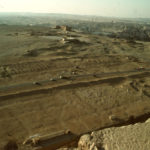
Khafre galleries: barracks or storage?
Petrie carefully described the composition and dimensions of the galleries, which are 30 meters (98.4 feet) long and 3 meters (9.8 feet) wide, extending from a back western wall of an enclosure 400 meters (1312.3) long and 85 meters (278.8) wide. He noted “many fragments of statues were found, in diorite and alabaster, of the fourth dynasty style: and among a large quantity of quartzite scraps lying on the surface…part of a life-size head.” (The Pyramids and Temples of Gizeh, Petrie, 1883).
Royal statue fragments might be out of place in a workman’s barracks and Petrie described no cultural material that would indicate the domestic life of a barracks.
Giza Plateau Mapping Project excavations: 1988-89
In order to test Petrie’s hypothesis, which had been accepted by Egyptologists for over 100 years, we proposed to re-excavate Petrie’s barrack galleries along with two other areas at Giza to look for evidence of a pyramid-age settlement.
Using our GPMP survey control network, surveyor David Goodman ran three north-south lines along the 30 meter wide (98.4 feet) barrack structures, creating front, back, and middle divisions. Then we opened about 11 excavation squares in the front, middle, or back of the galleries.
Evidence of craftwork
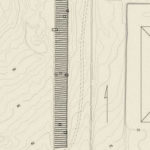
The galleries
Near the entrances of one gallery we found fragments of figurines: lion figurines, a small statue of a king, and what looked like possible models of larger architectural pieces.
We found rear portions of the galleries nearly empty. If workmen had been living, cooking, and sleeping in these galleries for decades, we would expect to find the kind of settlement debris so common wherever people lived in ancient times: pottery, ash, bone, and other refuse.
The figurines, along with pieces of copper, malachite, and feldspar, were evidence of craft working, leading us to the conclusion that Petrie’s barracks were not barracks at all.
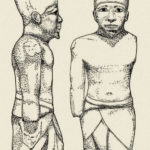
A royal figurine.
The material we found suggests that at least parts of the galleries were used as a craft production area. But the overall structure is huge. Other galleries may have been used for storage, perhaps even grain storage, though we didn’t find good evidence for grain.
Alternatively, most of the galleries may have been left empty, a state administrator’s idea that never took final form. The galleries may have served as symbolic storage for the pharaoh’s afterlife like the vast underground galleries west of the Step Pyramid complex at Saqqara, and they may never have been used at all.
So if Petrie was wrong, where did the ancient pyramid builders live?
(For more on the Khafre galleries, see Lehner and Conard, Journal of the American Research Center in Egypt, XXXVIII, 2001.)
Another settlement location?
Mark Lehner had proposed another possible settlement location (see MDAIK 41, 1985)—but while initially promising, Area B quickly proved an unlikely location.
Area B is a broad elevated bowl on the Maadi Formation due south of the Great Pyramid. Karl Kromer excavated the northeastern part of the bowl (1971-1975), revealing a sizeable dump of settlement debris.
Kromer found seal impressions with the names of Khufu (2551-2528 BC) and Khafre (2520-2494 BC) but none of Menkaure (2490-2472 BC). He was probably right in his assessment that the cultural material was dumped from an ancient settlement that was razed somewhere nearby.
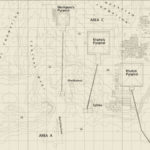
Area C at top, Area A lower left
When we inspected the bottom of the bowl early in the 1988-89 season, we found natural marl clay just below a shallow sand cover. The bowl may have been a quarry for tafla, the buff-colored desert clay that the ancient builders used as plaster and mortar in ramps and embankments.
It’s possible that a settlement once occupied Area B, and that the quarrymen razed the settlement, dumping the material to a far corner as they exploited the bowl for more tafla. It is also possible that the settlement remains derived from an older phase of occupation that the builders removed from Area A.
We therefore decided to focus our efforts on Area A.
A city under the sand
In 1934, Egyptian archaeologist, Selim Hassan excavated test trenches in a patch of low desert extending about 450 meters (1476.3 feet) south of a colossal stone wall called Heit el-Ghurab (Wall of the Crow). The wall is situated some 400 meters (1300 feet) south of the Sphinx. Hassan hit mud-brick walls and pottery in all his trenches, indicating that ruins of a large settlement lay below the thick sand layer that blanked the site.
Hassan’s 1934 results, together with more pottery and mud brick walls exposed when people from nearby riding stables removed the sand cover, led Mark Lehner to propose in his MDAIK article that a major settlement of the 4th Dynasty once thrived south of the Wall of the Crow. We designated this Area A.
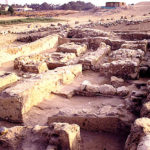
The Lost City walls.
We limited our 1988-89 excavation in Area A to five 5 X 5 meter squares (16.4 X 16.4 feet) just at the base of the sandy eastern slope of the Maadi Formation ridge. Every square produced evidence of ancient settlement. The easternmost of these squares (Squares A1, A2, and A4) produced the most promising evidence of a settlement for workers.
We found two buildings in these squares: one building of alluvial mud brick and another of stone and mud mortar, plastered inside with tafla (desert clay).
The late phase of activity in these squares was connected with bread making. We recovered a considerable number of sherds (broken pottery) from large, bell-shaped bread moulds, of the kind called bedja in Old Kingdom scenes. It appeared that these were dumped all at once, suggesting a bakery in the vicinity.
Between the stone building and the mud brick structure we found an alleyway filled with a dense refuse deposit rich in bone, ash, sherd, and a number of clay sealings bearing the name of Menkaure, builder of the third Giza Pyramid. Unlike Kromer’s sealings in Area B, we found our sealings in secure context within a settlement.
The main building, of fieldstone and clay, contained a series of pedestals in two rows separated by a center wall. The pedestals appeared to be the foundations for storage compartments.
A small closet-like compartment in the northeast corner contained three, smaller pedestals. We called this the Pedestal Building. In subsequent seasons, we have found many more of these pedestals in small compartments and in long running rows at various places across the site.
In 1988-89, one old hypothesis had been tested and found wanting: Petrie’s barracks were probably not barracks. Another hypothesis proved to be problematic: Area B might once have contained a settlement but, if so, it was removed in antiquity.
Area A was just beginning to reveal its secrets. The Pedestal Building would prove to be only the tail of a huge archaeological beast: the Lost City of the pyramid builders.
